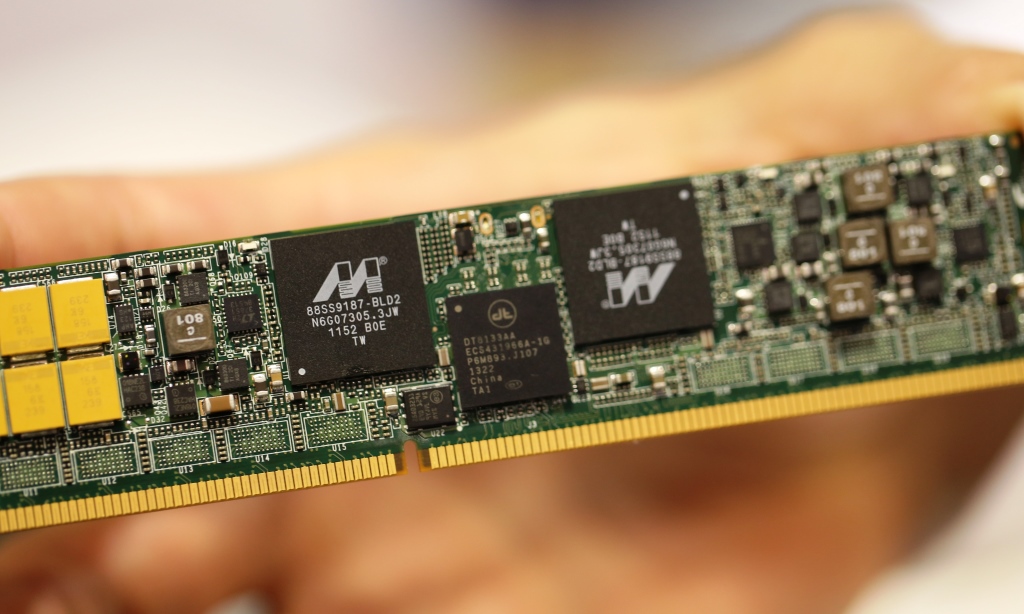SanDisk Corporation, a world-leading producer of flash storage products, is announcing that it has begun shipping (for qualification) their ULLtraDIMMTM Solid State Drive. The ULLtraDIMM represents the storage industry’s first enterprise-class, ultra-low latency, memory channel storage solution geared towards servers. As use of flash storage technology continues to grow in enterprise data centers, adding flash technology onto the DRAM memory channel(s) should help increase SanDisk’s penetration, and augments their existing flash-based hardware and software lineup.
SanDisk’s award-winning ULLtraDIMM SSD, produced in partnership with Diablo Technologies, can be integrated into existing DIMM slots, and results in ultra-low latency and dramatically improved application responsiveness. By adding additional ULLtraDIMM SSDs to available DIMM slots, performance and capacity can be scaled up with no effect on latency. This allows for an entirely new server system design architecture, supporting usage scenarios that require ultra-fast storage, such as High-Frequency Trading (HFT), transaction processing, VDI, virtualization and cloud computing.
According to John Scaramuzzo, senior vice president and general manager of SanDisk’s Enterprise Storage Solutions division, “The SanDisk ULLtraDIMM SSD was designed to expand the reach of ultra-low latency flash storage throughout the data center and scale up to meet the requirements of any enterprise application, no matter how bandwidth or capacity intensive. The ULLtraDIMM SSD’s linear performance scalability and innovative DIMM form factor allow organizations to deploy flash as their application requirements change, without requiring significant infrastructure investment.”
IBM will be utilizing SanDisk’s ULLtraDIMM SSD under the eXFlash brand name, as they have already tested the ULLtraDIMM SSD under a variety of enterprise workloads and end-user applications. Early benchmarks produced by IBM showed that the eXFlash DIMM SSD was able to achieve 5-10 microsecond write latency — the lowest in the industry to date. IBM has also announced that the eXFlash DIMM will be available as an option for their x3850 and x3950 X6 servers, and can provide up to 12.8TB of flash capacity.
Initially available in capacities of 200GB and 400GB, SanDisk’s ULLtraDIMM SSD is rated for 1000 MB/s reads and 760 MB/s writes, with random 4K reads of 150,000 IOPS and random 4K writes of 65,000 IOPS. For endurance, the ULLtraDIMM SSD features FlashGuard, allowing for up to 10 drive writes per day. Also featured are EverGuard backup power circuitry for power fail recovery, and DataGuard data path protection. SanDisk is backing the ULLtraDIMM SSD to the tune of a five-year warranty.
SanDisk has also begun shipping the ULLtraDIMM SSDs to other key partners for further qualification. You can view the ULLtraDIMM SSD product page here; and SanDisk’s press release on the ULLtraDIMM SSDs in its entirety here.
 The SSD Review The Worlds Dedicated SSD Education and Review Resource |
The SSD Review The Worlds Dedicated SSD Education and Review Resource | 


but can you boot your OS from it? Will we need new bios to support Ram bootable drives?
Bear in mind that these are being developed for enterprise applications, not for consumer use. They may eventually be developed for consumer use also, but that is likely still a ways down the road.
I do like the use of supercaps on the device as well as dual controllers, which I suspect drives a RAID 0 setup. From the product description it appears that you need to run some special software to manage the flash drive. These DIMMs are NOT byte addressable like real RAM, they just create an SSD drive that has VERY fast access times. They appear to use a full-buffering method of handling the data, command and clock signals to maintain integrity. I’d see these getting use on the large servers that have a few dozen DIMM slots available. These could be rather interesting in heavily virtualized environments.
As per Diablo website the memory channel architecture allows for byte addressable access. They do not specify when they will start supporting it. If it is supported then, it will be very interesting capability.